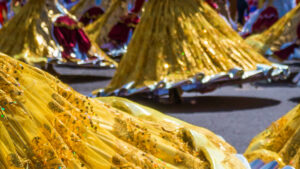While there are some dance fads that fade over the years – fingers crossed we never see the end of Gangnam Style – there are others that remain timeless. These are the ones that are typically steeped in tradition, that see dancers clad in elegant costumes and moving with emotion. Don’t get us wrong, we’re all for Switzerland’s chicken dance, but there are others that just embody a country’s vibes, like Spanish coolness or Turkey’s sultry side.
You probably won’t find these kinds of dances taking place on club dance floors, but they’re worth seeking out if only to attune yourself with the local culture. Plus, they’re pretty mesmerising to watch. To get your toes tapping, here are some traditional dances you can expect to see when visiting these European destinations.
Spain – Flamenco
Think back to that little dancer emoji on your phone – the woman in the red, floaty dress with her hands mid-clap. She’s wearing the traditional garment you might see on a flamenco dancer. Flamenco dancing is native to regions in Spain, accompanied by singing, clapping and snapping and some soulful guitars. Where flamenco is concerned, you can’t have one without the other.
Flamenco dancing is characterised by its strong, emotional movements. Dancers carry themselves proudly, waving their arms and stomping their feet in time to the beat. It’s an incredibly technical dance style that’s taken very seriously and studied in dance schools across the world.
Greece – Greek dancing
Dancing has always been a critical part of Greek culture, used by the locals to express themselves. Historically, dances were held at everything from religious celebrations and weddings to preparations for war. They’re still a key part of Greek’s modern culture, so much so you’ll even find them at neighbourhood tavernas on popular ‘Greek nights’, accompanied by plate smashing and live music.
Each region of Greece has its own unique spin on traditional Greek dancing, so depending on where you go, you’ll see slight variations in sharpness and pace. In general, dancers will assemble into a circle, holding onto one another by hand or on the shoulders, and step or leap in a counter-clockwise direction. What order you stand in can depend on age or social status within the community, and it’s best not to disrupt these traditions if you aren’t sure where to go.
France – Can-can
Odds are the traditional can-can song has already sprung into your head. That’s because this popular French dance is incredibly iconic, marked by its sky high energy and even higher leg kicks.
The can-can is traditionally performed in music halls by a chorus line of women, though it was often a dance for men in the 18th century. These days, many recognise it from its repeated appearance at the famous Moulin Rouge in Paris. Women dancing the can-can will almost always be wearing blustery skirts that billow upwards when dancers kick their legs – the dance used to be considered quite scandalous, but nowadays, isn’t complete without a few cartwheels and splits.
Italy – Tarantella
In Italy, traditional dances are generally hard to come by, though one has seemed to prevail over thousands of years – it’s known as the ‘tarantella’ kept alive mostly in southern Italy. Its beginnings are incredibly strange, coming about as a result of tarantula bites. When given the right music, the inflicted were supposed to snap out of their hysteria and begin dancing what is now known as the tarantella.
The tarantella is marked by its fast pace lead by a tambourine. It is generally performed by couples that skip and quick step around one another, turning and sweeping their arms. If you do stumble across locals performing this traditional dance, you can rest assured that they probably weren’t bitten by spiders in preparation.
Turkey – Belly dancing
Belly dancing is traditional across many Middle Eastern countries, referred to sometimes as ‘Oryantal Dans’ in Turkey. Turkish belly dancing stands out from other traditional forms in that it’s known for being very up tempo and energetic. Dancers will rhythmically jut out their hips while moving their arms and stomachs in a fluid motion. Each move must be carefully layered, so to be a great belly dancer, athleticism is key.
Turkish belly dancers will often stand in a line, blocking one another, so that their arm movements are all that can be seen. The dance is also punctuated by the use of finger cymbals chiming to the beat of the music. Today, coming across belly dancers in Turkey isn’t hard to do – you’ll find the traditional dance performed in restaurants and dance halls.
Germany – Polka
The polka actually began in what is now the Czech Republic, though this dance craze soon swept across Europe and has even become a popular genre within the United States. In Germany, it’s closely associated with oom-pah music, usually made with brass instruments and an accordion. In Germany, polka dances become especially popular around Oktoberfest.
The dance is traditionally upbeat, done in pairs or alone. Moving in tempo, dancers will hop and kick, adding in steps as they choose and keeping in time with the lively music. The polka is a loose dance that’s meant to be fun and hike up the energy in what were historically stodgy ballrooms.
Try the Flamenco on a sunny Spanish break…
https://www.holidayhypermarket.co.uk/details/30912/bahia-princess-hotel






